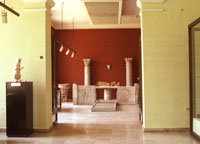|
|
|
Odessos and its Region in the Late Antiquity
/4th – 6th century
AD/
|
|
|
 |
The constant invasion of
tribes coming from the North of the Danube during the Late Antiquity
made for a change in the ethnic structure of the inner part
of the Thracian territories and there from in the cultural traditions
of the population.
These changes made an impact on the small
metal plastics from that period – these are the bronze belt
plates, the buckles, the fibulae, and various decorations. Some
of them belonged to the "barbarian people" – tribes invading
from the northern Black Sea steppes and settling in the territories
of the late Roman provinces of Mysia Secunda and Skytia Minor
/the Northeast Thrace/. |
A set of more than 30 medical instruments and
vessels from the 4th century AD found in Marcianopolis testify to
the good traditions in this profession.
New tendencies are to be followed in the development
of trades in the town represented by the local products of ceramics,
glass and metal.
The development of agriculture is evident from
the set of agricultural tools found in the fortress by the village
of Novakovo by Varna /6th century AD/.
Commerce continued to take a substantial part
in the life of the town – found are numerous bronze scales, parts
of balances, lead seals. Unique is the weight from a balance in the
form of a statuette of the Emperor Constantine the Great from the
4th century AD.
The various marble capitals from the 4th – 6th
century AD and the incredible figure of a panther from a fountain
dated 4th – 5th century AD introduce Odessos as one of the important
centers of stone cutting. At the same time, through the port of Odessos
marble from Asia Minor and the Prokonese region was imported. |
| À
r c h e a e o l o g i c a l m u s e u m V
a r n a |
|
www.varna-bg.com
© 1997, 2000; 2002
|
|



